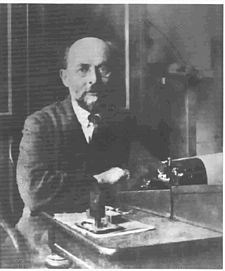Origins of biophotonics
The discovery of Alexander Gurwitsch
Around 1923 Alexander Gurwitsch discovers that living organisms (onions, yeast) emit an ultra-weak light and guesses that there might exist a connection with the stimulation of cell-growth. He gives the luminescence the name "mitogenetic radiation" and finds evidence that it may be located in the spectrum around 260nm (bibliography see "Gurwitsch," also Ruth (1977-1979).
After a preliminary enthusiasm for the discovery of Gurwitsch - only one vote was missing for him to get the Nobel Prize - his discovery was put in doubt, or dismissed as unimportant. Despite the fact that Gurwisch's discovery was verified many times and has never been disproven, "mitogenetic radiation" was forgotten, if not discredited. As late as in 1980 it was derided in Germany as "a miracle from the USSR."
Around 1950, Russian biophysicists study "ultra-weak photon emissions" (dark luminescence) from biological systems with the help of modern photon multipliers. The scientists publish their results mainly in the publication "Biophysics" (Biofizica). They keep bashfully silent about the connection with Alexander Gurwitsch's "mitogenetic radiation," but they too establish a correlation with cell growth. They verify that the radiance is emitted by practically all living organisms and that with advancing stages of evolution it seems to diminish in intensity. They find the first signs of correlation between the cell cycle and the emission of photons and also, surprisingly, a missing correlation between radical reactions and the emission of photons. (Bibliography, see Ruth (1979).
Italian nuclear physicists find weak "bioluminescence" in wheatsprouts which they had by chance put into their photon-multiplier apparatus for nuclear measurements. They let themselves be convinced by biologists that this discovery went back to Gurwitsch and had been proven to be an artefact, or unimportant. (Bibliography see Colli et al. 1954, 1955, Ruth 1979).
The Russian biophysicist Zhuralev and the American biochemist Seliger published the first working hypothesis about ultra-weak emission of photons by biological systems, the Theorie of "Imperfection:" the luminescence is supposedly caused by deviation from thermic equilibrium and therefore to be explained by disturbances in the metabolism. ("Imperfection," bibliography see Zhuralev 1972, Seliger 1975, Ruth 1979).
Around 1970, independently from each other and moved by entirely different motivations, working teams in Australia (Quickenden), Germany (Fritz-Albert Popp), Japan (Inaba) and Poland (Slawinski) verify the existence of ultra-weak photon emission by living organisms through the single-photon counting technique with then state of the art photomultiplier-detectors (bibliography see Quickenden, Inaba, Slawinski and Popp).
While the other scientists all accept the "Imperfection-Theory," the German research team around F. A. Popp at University of Marburg proposes a counter-hypethesis to the Imperfection-Theory:
- The luminescence stems from a coherent electromagnetic field existing in living organisms
- The mechanism is DNA and the corresponding resonators inside the cells;
- The mechanism is most easily explainable through light storage processes (for instance in hollow-room resonators) and specific channels of information.
- There is a relationship with delayed luminescence (prolonged light echo after excitation by external light) in living organisms.
- The radiance coordinates all the biochemical processes in the cell (intracellular communication) and conveys information also beyond the cells (intercellular communication)
- The radiance is not limited to the optical realm but extends in the specturm according to an f=const. law (probability of situation in phase space independent from wavelength) into which the so called "heat emission" of biological systems also fits.
- The luminescence could be the very regulator and information carrier within living organisms.
The Marburg research team around Dr Prof. F. A. Popp gives the phenomenon the name "biophotons" in order to express the difference with conventional "bioluminescence": it is due to single photons which are constantly emitted by living organisms. In the end, it is a quantum phenomenon which, because of its quasi continuous stream of photons and of its characteristics is to be found in all living organisms, and therefore must be considered an essential feature in all living system (bibliography see Popp).
Despite considerable mockery among German scientists, the concept of "biophotons" introduced by Prof. Popp is accepted worldwide.
Translated from the German by Ami de Grazia
The Light of All Life: the Struggle of Fritz-Albert Popp

Alexander Gurwitsch

